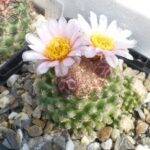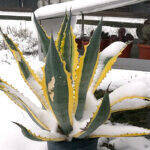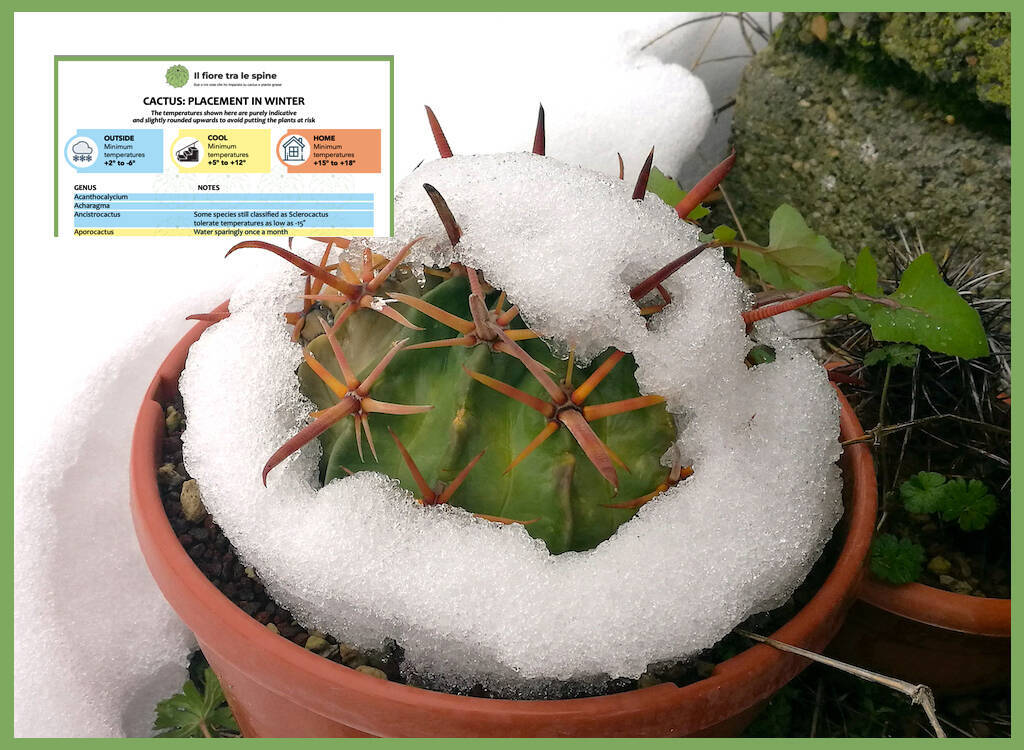A practical handbook and an in-depth analysis on a much debated topic among those who grow succulent and/or cactus plants. Here’s what you’ll find by reading this article, designed specifically to help those who, with the first drops in temperatures, are starting to wonder where to place their succulents when the real cold arrives. Unless you have a greenhouse, perhaps equipped with a burner regulated by a thermostat, the question is in fact more than pertinent: during the winter it is better to keep the succulent plants outside (sheltered from the rain), or in a cool environment such as a landing, an internal staircase or even a garage? Or should we bring all the plants indoors? It is good to clarify immediately that the answer to these questions cannot be tranchant or “absolute”: obviously the correct winter location depends on many factors, starting from the area in which the plants are grown (North or South Italy? North or South Europe? Sea or high mountains?) to arrive at the type of plant (Cactaceae, succulent native to Africa or Madagascar? Sempervivum, Crassula, Euphorbia?). In short, the range of cases is very broad and as always there are no absolute rules. Luckily there are many fixed points and many precautions that should be respected to ensure that our succulents pass the winter securely and take advantage of the vegetative stasis to be able to flower again the following year.
The following article answers these questions, and you will also find an indication of the correct measures to be taken to ensure that cacti and succulents overwinter in the best possible way, have abundant blooms and, above all, you’ll find a practical handbook with an indication of the best location for cacti and succulents organized in alphabetical order, so as to facilitate the identification of the plant, understand in which minimum temperature range it can stay and where it can be placed (for example outside, on a landing, or directly inside the house). (…)
Premise
Succulent plants, whether Cactaceae or succulent plants belonging to other families such as Crassulaceae, Asclepiadaceae, Euphorbiaceae, etc., are not houseplants. They can certainly adapt to home cultivation, but they are plants that require light, air and which find their best location in outdoor environments such as windowsills, terraces, gardens or open greenhouses. This, of course, in the growing season which generally runs from March to October. The problem, and therefore the focus of this article, is winter, also because not everyone has the possibility of having a greenhouse or a garden. Given the slight drop in temperatures in recent days, questions are growing regarding how to behave in view of the cold weather in the coming months. As always, given that succulents are a varied world, made up of thousands of botanical species, unfortunately there is no single answer. However, there are parameters and references on which we can rely to give the correct answer to the question regarding wintering. These parameters are essentially the guides underlying the handbook that you will find at the end of the article.
Attention: this article is designed specifically for those who are not yet very familiar with these plants and need practical information and quick answers: for example, I have this succulent, where can I place it when it gets cold? For more specific insights and tables with the minimum temperatures that succulents can reach, it is possible to refer to two other articles published in the past. The first article, accompanied by a table with minimum temperatures, can be found at this link. The second article, which deals with seasonal care in detail, can be reached via this link.
Cacti
Let’s begin to distinguish between Cactaceae and succulent plants in general. The distinction is not intended to complicate the matter, but rather to simplify it to more quickly identify the correct solution to the initial question: where to place the plants during the winter? If you want to learn more about the difference between a cactus and any other succulent (for example Euphorbia, Echeveria, Lithops), you will find this article helpful.

Almost all cacti tolerate low temperatures very well. By low temperatures we mean minimums close to zero Celsius degrees or even well below this value. The cacti can therefore also be placed outside as long as watering is completely suspended at the end of September and they are positioned in a cold place sheltered from the rain. These are also the essential conditions for the plants to flower from the following spring. Therefore, a terrace, a balcony or a garden are fine. The important thing is that the cacti do not take on water until the end of March and the temperatures do not fall below zero Celsius degrees for several consecutive nights. In the event of frost or prolonged nights with temperatures well below zero, it is advisable to move the plants to a less cold place, even if only temporarily. A useful precaution is to cover the cacti with at least two or three layers of non-woven fabric: naturally it doesn’t work miracles, but two or three degrees more ensures them and, above all, allows transpiration, preventing condensation from forming on the plants or a humid environment is created, which is very dangerous for these plants as it favors the formation of stains on the stem, mold and fungi. On sunny winter days it is useful to raise the tissue even for a couple of hours to ensure the plants have a good exchange of air. It is best to avoid small greenhouses closed by thick sheets of transparent plastic, unless you always leave them open during daylight hours.
An exception to this basic rule are some genera of cacti, which do not tolerate the cold and should therefore be kept indoors or in environments where temperatures do not fall below certain limits (for example an internal staircase, a landing or even a garage). In these cases it is not necessary for the plants to receive a lot of light because if we suspend watering the cacti go into stasis and stop growing. This avoids the risk of “etiolation”, i.e. the so-called “spinning” which disfigures the plant from an aesthetic point of view. Attention: however, if we see excessive wrinkling of the stem or branches of these cacti, particularly if they are wintering indoors, it is advisable to water in moderation, at most once a month. The cacti that do not tolerate the cold are those originating from tropical areas and forests: firstly the epiphytic cacti (Schlumbergera, but also Epiphyllum, Rhipsalis, Aporocactus); secondly, two species native to Brazil and the Cuban archipelago: Melocactus and Discocactus. All these plants must winter at minimum temperatures no lower than 12/14 Celsius degrees (Melocactus and Discocactus require even higher minimum temperatures, between 16-18 Celsius degrees): you will find all the indications and the reference to the genus in the handbook accompanying this article.
Succulent

In theory, for succulents the matter becomes a little more complicated. This is because the Cactaceae is a single family that is divided into genera, species and subspecies. Succulents, on the other hand, are distributed in various families which are in turn divided into genera, species and subspecies. The number of these plants is therefore very high and providing specific indications plant by plant is almost impossible. However, even in this case it is sufficient to set a few “boundaries” to make the matter less complicated. The first element to consider is the place of origin of the plant: many succulents come from Africa or Madagascar (for example Euphorbia and Lithops). Clearly these plants require higher minimum temperatures and cultivation at home or in an environment where the minimum temperatures do not drop below 10/12 Celsius degrees is ideal. Other families or genera, for example Agave, Sempervivum and Sedum, tolerate intense cold very well, in many cases even well below freezing.
Even with succulents it is advisable to suspend or at least reduce watering during the winter months, whether they are in a cold environment or in an apartment. During the winter months, in fact, almost all plants slow down in growth and frequent watering would only expose the specimen to the risk of root rot. Generally speaking, you can adjust as follows: from the end of October to the end of March, succulents should be placed in environments sheltered from rain and at temperatures between 7 and 16 Celsius degrees. There are many exceptions, such as the aforementioned Agave, Sempervivum and Sedum, which we can keep outdoors even without protection and letting them take the rain (as long as it is not torrential and lasts for whole days). Other plants, such as some species of Euphorbia, Echeveria, Lithops (the so-called “stone plants”), tolerate the cold well but must be kept dry and at temperatures between 2 and 7 Celsius degrees. Other plants native to Africa or Madagascar, such as Adenium obesum (called “Desert Rose”), Pachypodium (the so-called “Madagascar Palm”), Uncarina and several species of Euphorbia require several degrees more because they do not tolerate the cold: all these plants will therefore have to be brought indoors from at least mid-October, unless autumn is mild and the minimum temperatures remain high even in this period, as happens in the regions of Southern Italy, Southern France or in Spain.
The handbook that completes this article will also be useful to orient you between the needs of the various succulents.
The handbook
The handbook (actually the handbooks, since one is dedicated to cacti and the other to succulents). It is intended to be a useful tool for the still inexperienced grower or for the expert grower who is approaching a particular genre for the first time. Naturally, the handbook should be considered as a tool, a sort of “map” through which to orient yourself and should not be understood as an “absolute” compendium with dogmas or strict rules, also because the temperatures indicated have been “rounded” a little upwards precisely with the aim of not putting your plants at risk (for example if the range between 5 and 10 degrees is indicated, it is very likely that the plants included in this range can tolerate even a few degrees less). Many growers have conducted experiments discovering that certain plants can resist temperatures lower than what is commonly thought, just as others have found that plants considered rustic were not able to survive the winter (in these cases, however, it is more likely that unpredictable factors have occurred, such as frequent frosts or that the specimen itself was already weak or not in perfect shape).
How to read the handbook
The handbook – both for cacti and succulents – is designed for quick and easy consultation. The three icons consider three possible environments for the wintering of plants:
- the outside: the plants should be placed outside the house but sheltered from the rain and, for caution, protected by a few layers of non-woven fabric;
- environments protected from rain but without heating, such as a landing, an internal stairwell, a room in the house where the radiator has been closed. For succulents that fall into this “category”, at most, even a very sheltered corner of a balcony can be fine, as long as the plants are covered by at least four layers of non-woven fabric;
- the apartment: warm environment (generally between 18 and 20 Celsius degrees) and obviously protected from rain. In this case it is best to place the plants near a window and away from heat sources.
Each icon is color coded and genres are listed alphabetically. It is sufficient to scroll through the downloadable handbooks below, identify the genre whose needs we want to know and look at the color of the line in which the genre is written: depending on the color we then refer to the icon.
![]() Download the handbook on winter placement of cacti
Download the handbook on winter placement of cacti
![]() Download the handbook on winter placement of succulents
Download the handbook on winter placement of succulents
CULTIVATION CARDS – To further deepen your knowledge of a single genus of cactus or succulent, remember that in the website shop, at this link, detailed sheets are available in downloadable and printable PDF format with notions, anecdotes, curiosities and precise cultivation instructions. You can find the cards simply by scrolling through the shop, after the section dedicated to subscriptions.
SUBSCRIBE TO THE SITE – If you liked this article, subscribe to the site to have unlimited access to all the contents for one year or three months depending on the formula you choose. Here you will find terms and conditions.
SUBSCRIBE TO THE NEWSLETTER – If you want to receive the free newsletter every time new content is published, fill in the fields at this link!
Correlated articles
Succulents and cold: a table with reference values
Seasonal care for cacti and succulents
How to grow cacti: the handbook
© The texts, videos, photos and graphic elaborations of the site “Il fiore tra le spine” are original material and are covered by copyright. It’s forbidden to reproduce them in any way.



